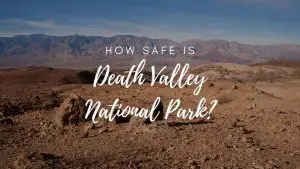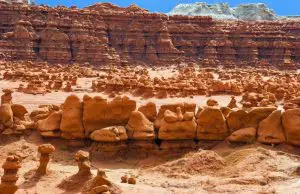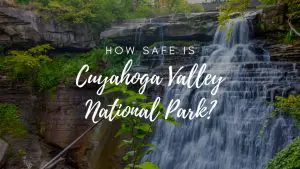Is Joshua Tree National Park Safe? (2023)

Joshua Tree National Park is a breathtaking desert oasis in Southern California, renowned for its stunning natural beauty, unique geological formations, and diverse wildlife. However, as with any outdoor destination, visitors may have concerns about safety and security within the park.
With reports of accidents, wildlife encounters, and crime incidents, it’s natural to wonder: is Joshua Tree National Park safe? Generally speaking, yes. In this article, we will explore the potential risks and hazards that visitors should be aware of, as well as the measures taken by park officials to ensure the safety of its visitors.
Quick Links
What Are The Biggest Dangers At Joshua Tree National Park?
As one of the most sought-after national parks in the United States, Joshua Tree National Park attracts millions of visitors each year, eager to explore its unique plant and animal life, and breathtaking rock formations. This vast desert landscape offers an array of activities such as hiking, camping, and rock climbing for outdoor enthusiasts of all levels.
To ensure a safe and enjoyable visit to Joshua Tree National Park, it’s important for hikers and campers (and casual explorers) to be aware of potential hazards. The park’s rugged terrain, unique wildlife, and extreme weather conditions can pose risks to visitors who are unprepared.
It’s ESSENTIAL to understand the most common dangers at Joshua Tree National Park and how to avoid them. In the following sections, so if you’re planning a trip to Joshua Tree – stay tuned. We will examine each of these hazards in detail, providing practical tips and advice to help you stay safe and make the most of your visit to this spectacular park.
Is Joshua Tree National Park Safe At Night?
When venturing out into nature, it’s important to take safety precautions, especially at night. Low visibility and more wildlife active at night are just a couple of dangers to be aware of. In Joshua Tree National Park, there are a few extra dangers to be aware of.
Here are some tips to stay safe while exploring Joshua Tree National Park at night:
- Stay on marked trails
- Don’t hike alone- let someone know your itinerary
- Be aware of your surroundings
- Carry a flashlight and plenty of water
- Wear appropriate clothing and footwear
- Avoid areas with steep drop-offs
Is It Safe To Go Alone To Joshua Tree National Park?
Hiking is a great way to get some exercise and enjoy the outdoors, but it is important to be aware of the risks of hiking alone. There are many potential hazards to be aware of, such as getting lost, injured, or encountering dangerous wildlife. However, by taking some simple precautions, you can greatly reduce the risks of hiking alone.
Joshua Tree National Park is a great place to hike, but there are some things to be aware of that can make it more dangerous to hike alone. The terrain in Joshua Tree can be very rugged, with lots of boulders and cliffs. This can make it easy to get lost or injure yourself if you’re not careful. There are also some dangerous animals in Joshua Tree, such as rattlesnakes and mountain lions. However, the chances of encountering these animals are very low if you take some simple precautions.
Here are some tips for hiking safely in Joshua Tree National Park:
- Stick to well-marked trails and carry a map
- Avoid hiking alone in remote areas
- Let someone know where you’re going and when you expect to return
- Be aware of your surroundings and watch for signs of danger
- Carry plenty of water and snacks, and hike at a comfortable pace
- Don’t hike in the heat of the day
- Wear appropriate clothing and footwear
- Pay attention to your body, and don’t push yourself too hard
Is It Safe To Drink Water In Joshua Tree National Park?
In Joshua Tree National Park, as with any wilderness area, it is important to be aware of the risks of drinking untreated water. While water from springs and streams may look clean, it can contain harmful bacteria and viruses that can make you sick. It is always best to purify water before drinking it, no matter where you are hiking.
There are a few different ways to purify water. One is to boil it for at least one minute. Another is to use a water filter, which can be either a pump filter or a gravity filter. You can also purify water with iodine tablets, drops, or a UV purifier. Whichever method you choose, be sure to follow the instructions carefully to make sure your water is safe to drink.
The Wildlife Of Joshua Tree National Park
If you’re hiking through Joshua Tree National Park, you may encounter some of the following wildlife:
- squirrels
- jackrabbits
- coyotes
- lizards
- snakes
- desert tortoises
- bighorn sheep
- mountain lions
While most of the wildlife in Joshua Tree National Park is harmless, there are a few animals that you should be aware of.
Biting Insects
There are a variety of biting insects in Joshua Tree National Park, including bees, wasps, hornets, yellow jackets, and flies. While most of these insects are just annoying, some can be dangerous. If you’re allergic to bee stings, be sure to carry an EpiPen with you. If you get stung, remove the stinger as soon as possible and wash the area with soap and water. Apply a cold compress to reduce swelling.
Spiders
There are two types of spiders in Joshua Tree National Park that pose a threat to humans: the black widow and the brown recluse. Both spiders are shy and will only bite if they feel threatened. If you are bitten by either of these spiders, seek medical attention immediately.
Rattlesnakes
There are several species of rattlesnakes in Joshua Tree National Park, and they are all venomous. If you are bitten by a rattlesnake, remain calm and still. Apply a compression bandage to the area and keep the limb below the level of your heart. Seek medical attention immediately.
Hiking Safety Tips For Joshua Tree National Park
When hiking in Joshua Tree National Park, there are some safety tips that you should keep in mind in order to have a safe and enjoyable experience. Here are some of the best ways to stay safe while hiking in the park:
- Stay on designated trails and avoid shortcuts. This will help you stay on track and avoid getting lost.
- Be aware of your surroundings. Watch for wildlife and be mindful of where you step to avoid slipping or falling.
- Bring plenty of water and snacks. It’s important to stay hydrated and fueled while hiking, especially in the heat.
- Tell someone where you’re going. It’s always a good idea to let someone know your hiking plans in case of an emergency.
Conclusion
In conclusion, if you’re planning to explore Joshua Tree National Park, it’s essential to take some precautions to ensure a safe and enjoyable experience. First and foremost, always hike with a partner and let someone know your plans. Stay on marked trails and be aware of your surroundings to avoid potential hazards. Don’t forget to carry plenty of water and food with you, especially if you’re planning a longer hike. Finally, be prepared for extreme weather conditions by checking the forecast and bringing appropriate clothing and gear.
By following these simple guidelines, you can make the most of your visit to Joshua Tree National Park and enjoy all the natural wonders it has to offer. Remember, your safety is a top priority, so take the necessary steps to stay safe and have a memorable trip.






